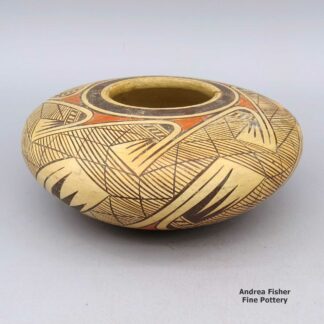Nampeyo, Fannie
Fannie Nampeyo was born in the Corn Clan home of her mother, Nampeyo of Hano, around 1900. She was the youngest daughter born to Nampeyo and Lesou. The older women of her father’s family gave her the name “Popongua” or “Popong-Mana,” which means “Picking Pinons.” It has been said the name “Fannie” was given to her either by missionaries or by health care workers on the Hopi Reservation.
Fannie attended the Polacca Day School, coming to the end of her formal education when she graduated from third grade.
While many young girls in the Hano-Tewa Village area of Hopi grew up learning how to make pottery alongside their mothers, Fannie didn’t. In her teens she worked at the Hubbell Trading Post as a maid and contributed to her family income that way. Among the women she worked with were Sadie Adams, Laura Lomakema and her niece, Rachel Namingha.
Fannie has been referred to as “tempestuous” in those days, and was judged least compatible with her mother. It wasn’t until after she married Vinton Polacca in the early 1920s that she began to be interested in making pottery. That was also about the same time her mother was beginning to lose her eyesight due to untreatable trachoma.
Fannie worked with her mother more and more, learning to polish from her father and how to decorate and paint from her mother. Fannie shared the painting duties with her niece, Daisy Hooee.
In those years, if a piece was signed, the signature was simply “Nampeyo” and as Nampeyo herself never learned to read or write, Fannie most likely did all the signing. Later pieces they collaborated on were signed “Nampeyo Fannie” while pieces Fannie made by herself were signed “Fannie Nampeyo” and usually included a Corn Clan symbol. Some pieces that were painted by Daisy were signed “Daisy Nampeyo.”
From the early 1920s until she passed away in 1987, Fannie was an outstanding and prolific potter. She most often made jars, cups, saucers, miniatures and bird effigy bowls. Her favorite styles were black on yellow and red and black on yellow. Her favorite designs appear to have also been the favorite designs of her mother: rain, clouds, feathers, stars and migration patterns. Fannie’s participation in the Hopi Show at the Museum of Northern Arizona in 1961 earned her a First Place ribbon.
After her mother passed on, Fannie became the Matriarch of the Hopi-Tewa Corn Clan, as her mother had been. Fannie didn’t just make pottery either: she developed a successful tamale business in Keams Canyon and she also made quilts. Fannie taught all her children how to make pottery and several of them excelled at it. All her children graduated from high school and most went on to graduate from college or university.
Some Exhibits that have featured work by Fannie
- Over the Edge: Fred Harvey at the Grand Canyon and in the Great Southwest. Heard Museum, Phoenix, AZ. Opened April 9, 2016
- Elegance from Earth: Hopi Pottery. Heard Museum, Phoenix, AZ. March 24, 2012 to April 6, 2014
- Choices and Change: American Indian Artists in the Southwest. Heard Museum North. Scottsdale, AZ. Opened June 30, 2007
- Buggin’ Art. Heard Museum West. Surprise, AZ. March 24, 2007 to August 26, 2007
- Our Stories: American Indian Art and Culture in Arizona. Heard Museum West. Surprise, AZ. Opened: June 6, 2006
- Home: Native Peoples in the Southwest. Heard Museum. Phoenix, AZ. Opened: May 5, 2005
- Every Picture Tells a Story. Heard Museum. Phoenix, AZ. September 20, 2002 to September 2005
- Hold Everything! Masterworks of Basketry and Pottery from the Heard Museum. Heard Museum, Phoenix, AZ. November 1, 2001 to March 10, 2002
- Recent Acquisitions. Heard Museum. Phoenix, AZ. July 12, 1997 to January 4, 1998
- Fred Harvey Pottery Exhibit. Heard Museum. Phoenix, AZ. August 3, 1996 to January 5, 1997
Showing all 4 results
-

Fannie Nampeyo, btho2l253, Polychrome jar with geometric design and fire clouds
$650.00 Add to cart -

Fannie Nampeyo, lkho2l304, Polychrome jar with geometric design and fire clouds
$2,800.00 Add to cart -

Fannie Nampeyo, lsho2g304, Polychrome jar with geometric design and fire clouds
$1,200.00 Add to cart -

Fannie Nampeyo, zzho2m510, Polychrome bowl with a geometric design and fire clouds
$995.00 Add to cart
Showing all 4 results